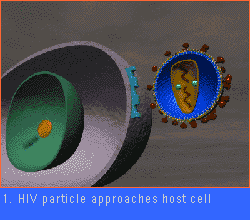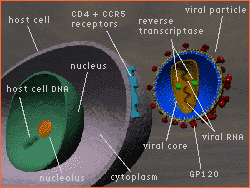
|
 |
 |
Viral Entry | Viral Gene Transfer | Viral Exit
This sequence shows an HIV particle approaching and attaching itself to a lymphocyte. (Lymphocytes, which include helper T cells and killer T cells, are small white blood cells that are critical in immune defense and are HIV's principal target.) In order to replicate itself, an HIV particle must get its RNA, which is the genetic blueprint for a new particle, inside the host cell. To do that, the viral particle must first bind to two chief receptors on the outside of the host cell, much like a key fitting into a lock. If even one of those receptors, which are known as CD4 and CCR5 receptors, is missing, the viral core containing the RNA will not get into the cell. (Researchers have found that some AIDS patients, known as long-term non-progressors because they are HIV-positive yet show few or no symptoms of the disease, are missing the gene for one of these receptors.) The binding process is facilitated by a molecule on the surface of the HIV particle called gp120 (for glycoprotein with a molecular weight of 120). Once the viral particle has successfully binded to the host cell, its core can pass through the cell wall into the cell's cytoplasm. The core then dissolves, leaving the RNA and catalyzing enzymes ready to begin the process of replication. Viral Entry | Viral Gene Transfer | Viral Exit Search for a Vaccine | See HIV in Action | AIDS in Perspective The Virus Fighters | Fighting Back | Help/Resources Teacher's Guide | Transcript | Site Map | Surviving AIDS Home Editor's Picks | Previous Sites | Join Us/E-mail | TV/Web Schedule About NOVA | Teachers | Site Map | Shop | Jobs | Search | To print PBS Online | NOVA Online | WGBH © | Updated October 2000 |

